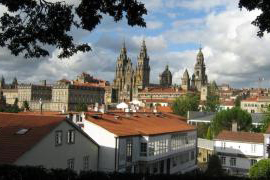
Would You Walk 500 Miles?
This month in EnRoute Magazine.
The place has a gravitational pull all its own. Just passing Amenal, 10 kilometers east, walking through a light rain, before I even glimpse the tips of its famous cathedral spires, I feel Santiago de Compostella like a spinning vortex just over the green rim of the Galician horizon. It moves people.
The Spanish town has had this effect for a long time. Consider that it was way back in the ninth century when the Apostle James’ tomb was reportedly found on a hill nearby. Word spread; people began to arrive. On foot, on horseback. Alone and in caravans. So many people that by the 12th century, an ambassador for Emir Ali ben Yusuf wrote back to his master, “So great is the multitude that comes and goes, that there is barely enough space on the pavement.”
That contemporary-sounding sniff of impatience puts the long-ago diplomat well ahead of the curve for tetchiness with tourism. But his comment also suggests how Santiago, well into its second millennium as a place to which people are drawn from all over the world, can be seen as a living case study of the relationship between all tourists and the places to which they travel.<?xml:namespace prefix = o />
If you plot the different routes of the Way of St. James (as the walk has come to be known), it now looks like a web of vines spreading from Santiago across the face of Europe, with branches stretching south of Rome and east of Prague, north across the sea to Sweden and Norway. I walked from Irun, in Basque Country, all the way west along the famous medieval Camino del Norte and Camino Primitivo routes. I did this at the behest of a friend of mine, who – after a long dinner together and well into our post-prandial Calvados – mounted a surprising and persuasive case that we make this more-than-800-kilometre trip.
I’m glad I did it for a number of reasons, several of which I couldn’t have predicted, including the opportunity to encounter one of the world’s most enduring travel destinations. Santiago as ur-destination, as ancestor to all those secular Meccas that have followed in the Western travel tradition, highbrow or otherwise: Paris, Las Vegas, Venice, Puerto Vallarta. Name a destination and you’ll find people visit it in a patterned way – which is perhaps only made plain in Santiago because of the pilgrim-yearning that is sharpened in even the lay visitor after hundreds of kilometres and however many blisters have been invested in getting here. In the massive central Praza do Obradoiro, over which the gothic cathedral looms, thousands of individual journeys are completed in the same moment. To find yourself in Santiago is to feel part of an ageless act of arrival. You feel a collective rush.
In Santiago, this means that thousands of people who’ve been walking for weeks all decide at once that it’s time to go for dinner. They spread out at the city’s patio tables. They sit in gossipy groups around its fountains. They pack into the narrow bars. They eat roasted pork shoulder at Casa Manolo and fish stew at Don Gaiferos. They sample the tuna empanadas at O Dezaseis and the filloas (crepes) at San Clemente. Or they simply follow the river of people down into Rúa do Franco, where virtually every door opens onto a cool dark room in which Galician deliciousness may be found. And if they’re very lucky, that means a bar stool at Taberna do Bispo, where they can eat morcilla sausage or garlicky prawns or patatas bravas. They bask in the difference between all previous moments, when they were merely heading toward this place, and the brilliant moment now, when they find themselves truly in it.
In Santiago, where most people have devoted many more days to the journey than they have to the destination, it doesn’t take long before you see the reflection of this, first in others and then in yourself. At some point, you start to notice people away from their groups, perched on a bench in Praza da Quintana, or staring off into space in the nave of the cathedral. Or perhaps you find yourself sitting on the green hillside of the Carballeira de Santa Susana one afternoon, tucked under one of the ancient oaks, wordlessly taking in a view of the cathedral across the red roofs and tight streets of the old town, no cars to be heard. It could be the 12th century. It could be the ninth. It could be the 24th. The wink of a timeless moment, as your own experience is linked into the human ages, is entirely worth the trip. It’s either the moment you realize you’re going home, or the moment you realize you aren’t, ever.
For most of us, most of the time, it’s the former. But either way, one trip draws to a close just as another one begins.

